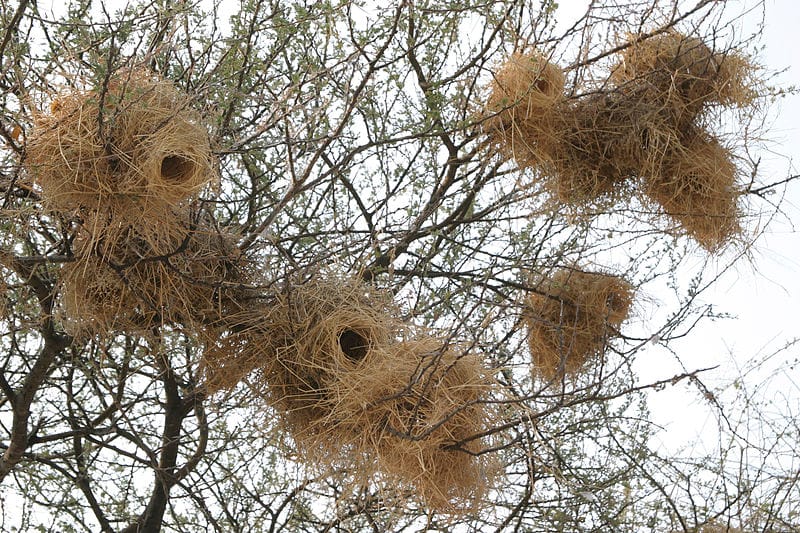A New Tyre Becomes Old

Nests of White-browed Sparrow-weavers in an acacia tree, Bechuanaland (now Botswana).
A New Tyre Becomes Old
Tim Hughes and his friend Ian arrived on their bicycles at his Uncle John Millard, the Divisional Commissioner of northern and western Bechuanaland, in Francistown. John was horrified that they had biked through man-eating lion country. Corrine, his beautiful wife, gave them a wonderful dinner. In the morning Uncle John put them on the mail train with enough money to travel to Jack Chase the Lion Hunter in Mahalapye and return to Bulawayo.
A New Tyre Becomes Old
Jack met them at Mahalapye. In a couple of days, they were going to inspect maas production in the villages for the Department of Agriculture. (Maas, curdled milk, is a mainstay of the African diet as adult Africans are often lactose intolerant.)
They crammed themselves on the front bench seat of Jack’s Model T and Phineas, his African assistant, perched himself on top of the camping gear stacked in the back. They headed west into the Kalahari Desert along the tracks which arose from sleighs pulled by oxen or donkeys. A sleigh was a “V” shaped tree trunk, that lay flat on the ground, with slats in between for a platform.
The Model T had no windscreen. The day was hot and clear. Tim held Jack’s .333 rifle between his knees with the barrel pointing upwards. It was ready, loaded for Jack to shoot a buck for their evening meal. The thorn scrub was thick. They couldn’t see beyond 50 yards.
Suddenly Phineas alerted Jack there were impala ahead. Jack grabbed the rifle and fired but missed. He blamed Tim for bumping up his sights. Tim knew all about rifles and had done nothing of the sort but kept his mouth shut. They had vegetables for dinner. “If that had been a lion, we could have been killed” Jack fumed as he went to bed. The next day, before 7 am, he shot a kudu bull and forgot about the impala. Sometimes the track between the thorn trees was so narrow that he had to detour. They had a puncture and replaced the flat with the spare. At noon, Jack stopped at an African store, bought warm cold drinks and told Phineas to repair the flat tyre.
Half an hour later he emerged and exclaimed, “There are 32 proper punctures in this new tube that is now old.” He had found 31 thorns that hadn’t let the air out! The 32nd was just too many, so it went flat. (In order to show he was always busy, he would hand pump up all the tyres every day.) Jack bought all the bicycle patches at the store and Phineas soon had the spare ship shape.
As the afternoon wore on, Tim noticed the sun was going down in the east! He shut his eyes. When he looked up at the sun again he realized it was the west after all. Without a horizon in flat sandy country, thick with thorn bush, during the middle of the day it is easy to lose one’s sense of direction.
“Jack, how do you know which way you are going if it is overcast?” asked Tim.
“Look at the white-browed sparrow-weaver’s nests,” (Plocepasser mahali).
Tim saw that the nests were on the western side of the acacia thorn trees, away from the prevailing wind. Nearly every big tree had lots of nests. He knew a single pair of those birds construct a dozen new nests each year, in which they roost separately. They don’t need water and can live for ten years.
Jack completed his tour. He and his wife were not used to young men with large appetites lazing around the house and Tim realized it was time to get on that train back to Bulawayo. Jack loaded their backpacks with biltong and invited them to visit again. Tim never took up Jack Chase’s offer but he heard he bought a pub in Mahalapye called Chase Me Inn.
Many Thanks to Tim Hughes of Queensland, Australia for the excerpts from his unpublished manuscript Matambega and Son written in the 1980’s. Picture from http://hu.wikipedia.org/wiki/F%C3%A1jl:White-browed_Sparrow-weaver_Nests.jpg
